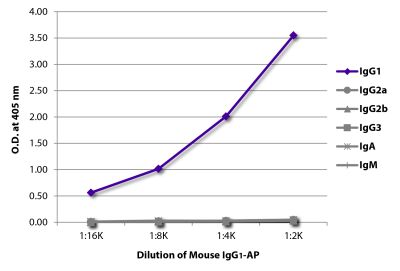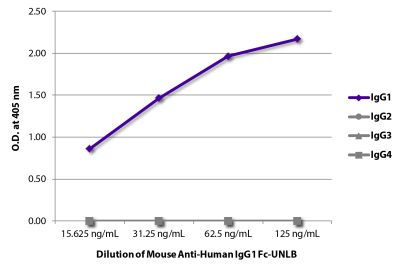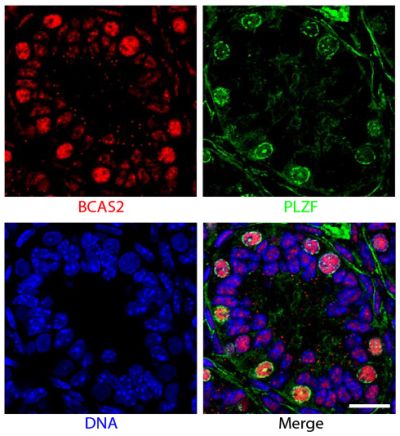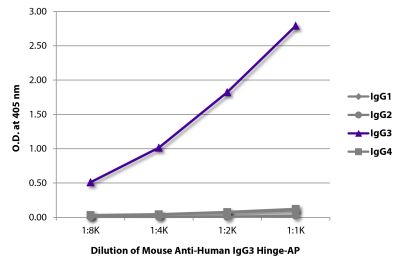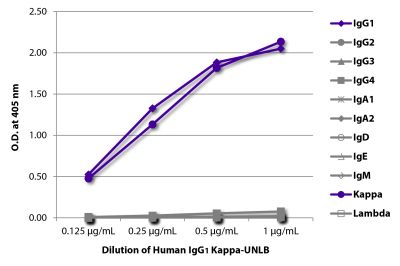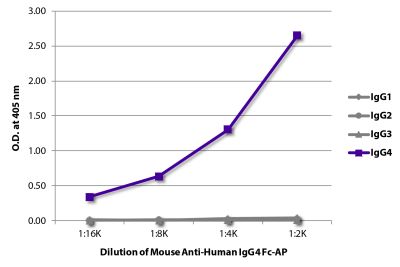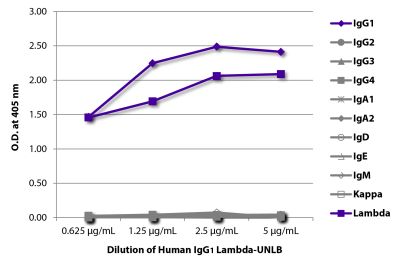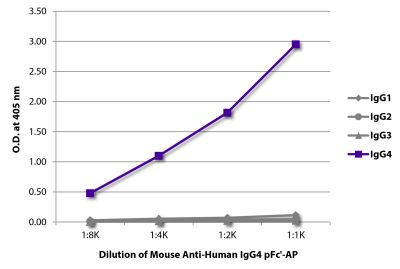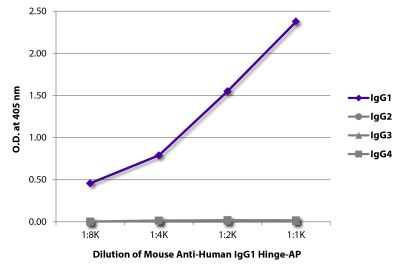Mouse Anti-Human IgG2 Fc-AP (31-7-4)
Cat. No.:
9060-04
AP Anti-Human IgG2 Fc antibody for use in ELISA, immunocytochemistry, western blot, and ELISpot assays.
$250.00
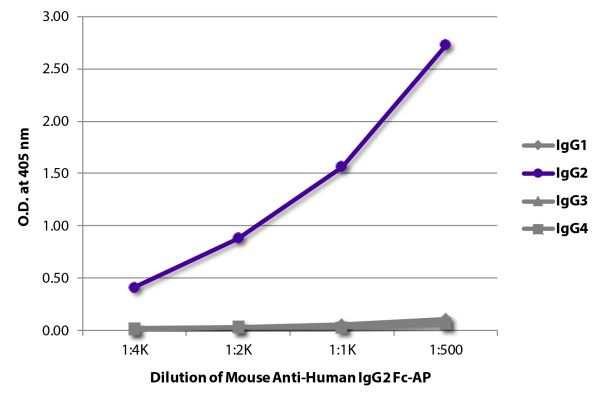

| Clone | 31-7-4 |
|---|---|
| Isotype | Mouse (BALB/c) IgG1κ |
| Isotype Control | Mouse IgG1-AP (15H6) |
| Specificity | Human IgG2 Fc |
| Immunogen | Human IgG2 myeloma protein |
| Conjugate | AP (Alkaline Phosphatase) |
| Buffer Formulation | 50 mM Tris/1 mM MgCl2/50% Glycerol containing < 0.1% sodium azide, pH 8.0 |
| Clonality | Monoclonal |
| Concentration | Lot specific |
| Volume | 1.0 mL |
| Recommended Storage | 2-8°C |
| Applications |
ELISA – Quality tested 2-12 FLISA – Quality tested ELISpot – Reported in literature 13 Flow Cytometry – Reported in literature 15-17 Immunocytochemistry – Reported in literature 1 Western Blot – Reported in literature 6,14 Multiplex – Reported in literature 7,18-22 Note – For direct immunostaining of IgG2 positive cells in flow cytometry applications, clone HP6002 (SB Cat. No. 9070) is recommended |
| RRID Number | AB_2796632 |
| Gene ID |
3501 (Human) |
| Gene ID Symbol |
IGHG2 (Human) |
| UniProt ID |
P01859 (Human) |
| UniProt Name |
IGHG2_HUMAN (Human) |
Documentation
Certificate of Analysis Lookup
Enter the Catalog Number and Lot Number for the Certificate of Analysis you wish to view
- 1. Conley ME, Brown P, Bartlet MS. IgG subclass potential of surface IgM-negative and surface IgM-positive human peripheral blood B cells. Clin Immunol Immunopathol. 1987;43:211-22. (Immunogen, ICC)
- 2. Arnold M, Zacher T, Dechant M, Kalden JR, Doxiadis II, Spriewald BM. Detection and specification of noncomplement binding anti-HLA alloantibodies. Hum Immunol. 2004;65:1288-96. (ELISA)
- 3. Bogdanos D, Baum H, Okamoto M, Montalto P, Sharma UC, Rigopoulou EI, et al. Primary biliary cirrhosis is characterized by IgG3 antibodies cross-reactive with the major mitochondrial autoepitope and its Lactobacillus mimic. Hepatology. 2005;42:458-65. (ELISA)
- 4. Whary MT, Sundina N, Bravo LE, Correa P, Quinones F, Caro F, et al. Intestinal helminthiasis in Colombian children promotes a Th2 response to Helicobacter pylori: possible implications for gastric carcinogenesis. Cancer Epidemiol Biomarkers Prev. 2005;14:1464-9. (ELISA)
- 5. Njoku DB, Mellerson JL, Talor MV, Kerr DR, Faraday NR, Outschoorn I, et al. Role of CYP2E1 immunoglobulin G4 subclass antibodies and complement in pathogenesis of idiosyncratic drug-induced hepatitis. Clin Vaccine Immunol. 2006;13:258-65. (ELISA)
- 6. Bogdanos D, Pusl T, Rust C, Vergani D, Beuers U. Primary biliary cirrhosis following Lactobacillus vaccination for recurrent vaginitis. J Hepatol. 2008;49:466-73. (ELISA, WB)
- 7. Arnold M, Dechant M, Doxiadis II, Spriewald BM. Prevalence and specificity of immunoglobulin G and immunoglobulin A non-complement-binding anti-HLA alloantibodies in retransplant candidates. Tissue Antigens. 2008;72:60-6. (ELISA, Multiplex)
- 8. Pratt-Riccio LR, Sallenave-Sales S, de Oliveira-Ferreira J, da Silva BT, Guimarães ML, Santos F, et al. Evaluation of the genetic polymorphism of Plasmodium falciparum P126 protein (SERA or SERP) and its influence on naturally acquired specific antibody responses in malaria-infected individuals living in the Brazilian Amazon. Malar J. 2008;7:144. (ELISA)
- 9. Xue L, Johnson R, Gorovits B. Prevalence and isotypic complexity of the anti-Chinese hamster ovary host cell protein antibodies in normal human serum. AAPS J. 2010;12:98-106. (ELISA)
- 10. Pratt-Riccio LR, Bianco C Jr, Totino PR, Perce-Da-Silva Dde S, Silva LA, Riccio EK, et al. Antibodies against the Plasmodium falciparum glutamate-rich protein from naturally exposed individuals living in a Brazilian malaria-endemic area can inhibit in vitro parasite growth. Mem Inst Oswaldo Cruz. 2011;106 Suppl 1:34-43. (ELISA)
- 11. Geisler WM, Morrison SG, Doemland ML, Iqbal SM, Su J, Mancevski A, et al. Immunoglobulin-specific responses to Chlamydia elementary bodies in individuals with and at risk for genital chlamydial infection. J Infect Dis. 2012;206:1836-43. (ELISA)
- 12. Chu SY, Yeter K, Kotha R, Pong E, Miranda Y, Phung S, et al. Suppression of rheumatoid arthritis B cells by XmAb5871, an anti-CD19 antibody that coengages B cell antigen receptor complex and Fcγ receptor IIb inhibitory receptor. Arthritis Rheumatol. 2014;66:1153-64. (ELISA)
- 13. Lue C, Tarkowski A, Mestecky J. Systemic immunization with pneumococcal polysaccharide vaccine induces a predominant IgA2 response of peripheral blood lymphocytes and increases of both serum and secretory anti-pneumococcal antibodies. J Immunol. 1988;140:3793-800. (ELISPOT)
- 14. Bogdanos D, Pares A, Baum H, Caballeria L, Rigopoulou EI, Ma Y, et al. Disease-specific cross-reactivity between mimicking peptides of heat shock protein of Mycobacterium gordonae and dominant epitope of E2 subunit of pyruvate dehydrogenase is common in Spanish but not British patients with primary biliary cirrhosis. J Autoimmun. 2004;22:353-62. (WB)
- 15. Jackson AM, Lucas DP, Melancon JK, Desai NM. Clinical relevance and IgG subclass determination of non-HLA antibodies identified using endothelial cell precursors isolated from donor blood. Transplantation. 2011;92:54-60. (FC)
- 16. Jackson AM, Kuperman MB, Montgomery RA. Multiple hyperacute rejections in the absence of detectable complement activation in a patient with endothelial cell reactive antibody. Am J Transplant. 2012;12:1643-9. (FC)
- 17. Toyoda C, Suzuki Y, Tsuneyama H, Onodera T, Masuno A, Yabe R, et al. Production of human monoclonal anti-Jk3, recognising an epitope including the Jka/Jkb polymorphic site of the Kidd glycoprotein. Transfus Med. 2014;24:286-91. (FC)
- 18. Hönger G, Hopfer H, Arnold M, Spriewald BM, Schaub S, Amico P. Pretransplant IgG subclasses of donor-specific human leukocyte antigen antibodies and development of antibody-mediated rejection. Transplantation. 2011;92:41-7. (Multiplex)
- 19. Lowe D, Higgins R, Zehnder D, Briggs DC. Significant IgG subclass heterogeneity in HLA-specific antibodies: Implications for pathogenicity, prognosis, and the rejection response. Hum Immunol. 2013;74:666-72. (Multiplex)
- 20. Arnold M, Ntokou I, Doxiadis II, Spriewald BM, Boletis JN, Iniotaki AG. Donor-specific HLA antibodies: evaluating the risk for graft loss in renal transplant recipients with isotype switch from complement fixing IgG1/IgG3 to noncomplement fixing IgG2/IgG4 anti-HLA alloantibodies. Transpl Int. 2014;27:253-61. (Multiplex)
- 21. Schaub S, Hönger G, Koller MT, Liwski R, Amico P. Determinants of C1q binding in the single antigen bead assay. Transplantation. 2014;98:387-93. (Multiplex)
- 22. Lefaucheur C, Viglietti D, Bentlejewski C, van Huyen JD, Vernerey D, Aubert O, et al. IgG donor-specific anti-human HLA antibody subclasses and kidney allograft antibody-mediated injury. J Am Soc Nephrol. 2016;27:293-304. (Multiplex)
See More


